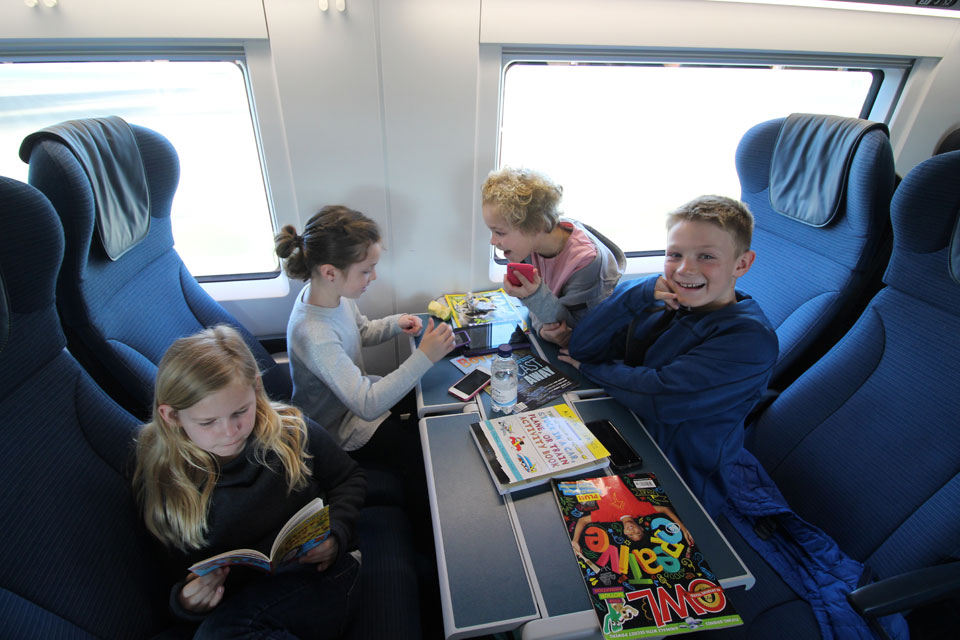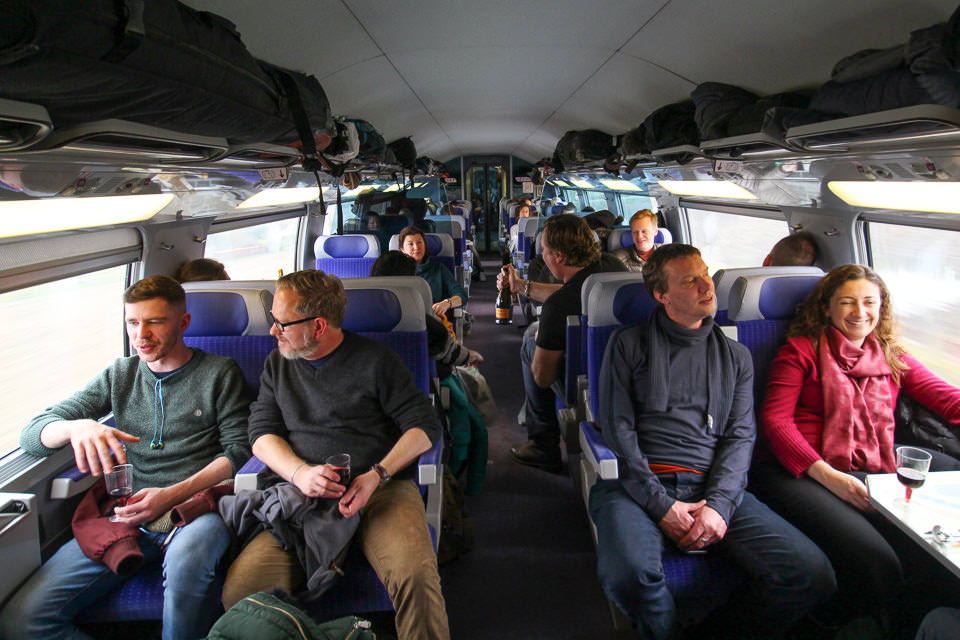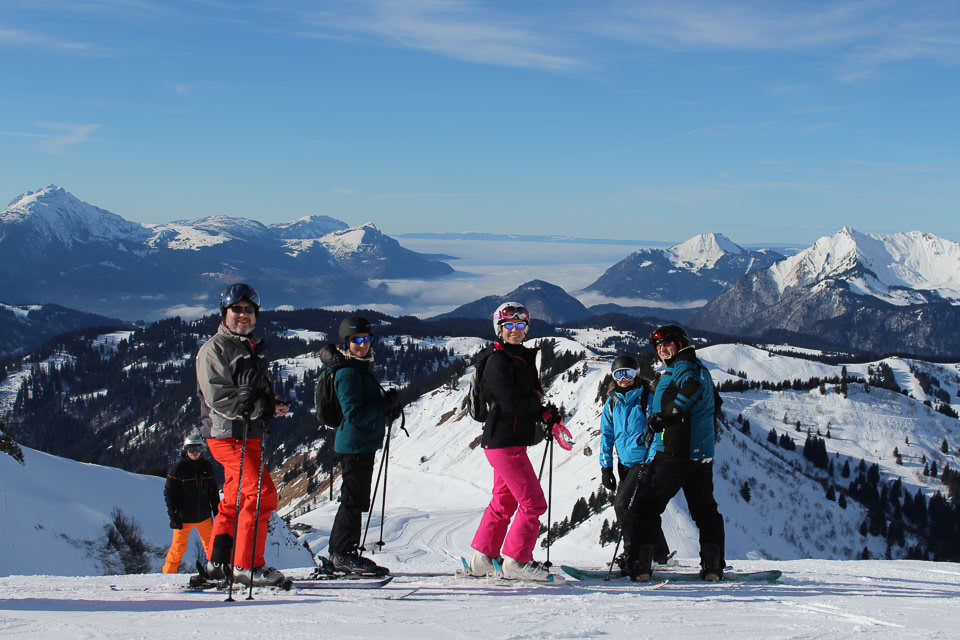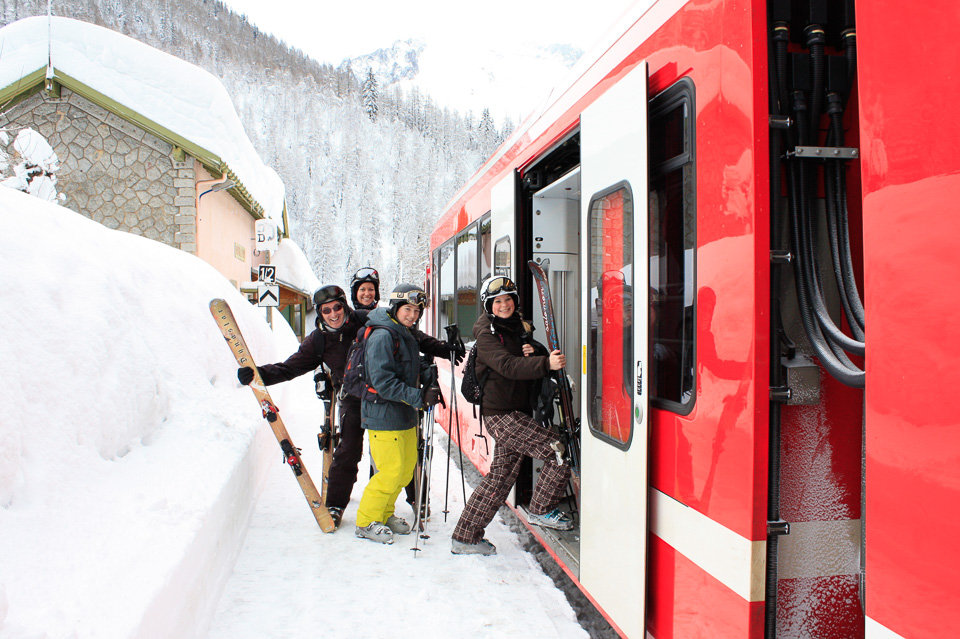Why train?
Rail travel to ski resorts is such a different experience from flying or driving. Here are some of the reasons why I switched from plane to train. By Daniel Elkan
There’s space
Who likes being cooped up when they travel? When you go by train, there’s space. Compared with flying or driving, it can feel like being a free-range chicken instead of a battery one. Get up when you want, take a walk down to the café bar or even ¬ on some trains – the restaurant carriage. And when you’re sitting, there’s more legroom too.
A friend of mine once described the train journey as ‘like being in your lounge as it moves towards the Alps’. I wish my lounge actually could do that.
You get quality time
 Children on board EurostarPhotograph: Daniel Elkan
Children on board EurostarPhotograph: Daniel Elkan
I’m talking about big blocks of quality time, several hours in one go. These chunks of time actually excite me: an opportunity that’s too long to waste. Whether it's engaging in conversation with friends, catching up on reading, watching a film, working on projects, or even attempting to learn a magic trick (with a captive audience), the journey with your travel companions becomes an experience in itself. All this, with ever-changing scenery framed by the window.
It's difficult to achieve this when you fly. The stop-start nature of airports, queues, cramped flights and transfers inhibits any real connection with your fellow travellers; Going by plane chops time into unsavoury bits, in a journey devoid of human feeling. You’re moved through liminal space, A to B, but little gets achieved apart from you physically getting close to the snow. By train, you become present in your journey and with the people around you. It’s different.
It can be as fast as flying, door to door
People often assume rail travel takes much longer than flying. So often, this just isn’t the case, door to door. On ski holidays, I’d often chat with other skiers I’d meet (who had flown) about travelling to whichever resort we were in (as well as other resorts). Skiers were constantly surprised to hear that going by train could actually be as fast as flying. In many cases, it almost didn’t compute.
What better way to prove this to a wider audience, I thought, than with an actual real-time race from London to the Alps. So, I challenged ski journalist Neil English to reach the hot tub of a chalet in Méribel before me and we filmed it, Top Gear style. There was only 35 minutes difference between the two journeys ¬– but a huge difference in the experience.
The difference is that the train journey has quality blocks of time that you can use, instead of moving from airport queue to airport queue to long transfer when you fly.
It's so much more social
 Photo: Daniel Elkan
Photo: Daniel Elkan
For years, I’ve organised holidays for friends where about 24 of us go by train to a catered chalet. Not everyone knows each other at the start. But from the moment people meet at St Pancras and we board the Eurostar, some kind of magic happens socially: people bond en route, getting to know each other as the journey progresses. It’s a shared adventure. After experiencing the camaraderie and fun of group train travel, I wouldn't consider organizing a holiday any other way.
It's scenic
What’s going on through the train windows? Well, everything. Like a huge roll of a mad, ever-changing film. Landscapes glide by, morphing from flatland to hills, to lakeside vistas. Cities, towns, villages, the arrangement of plants and items in a back garden. Speeds change, sometimes it’s an undulating whizz, sometimes it’s a cruise past the minutiae of life. A window out of the train is a view onto all the life that lives between you and your destination.
Extra time on the slopes
 Photo: Daniel Elkan
Photo: Daniel Elkan
If a journey to the slopes involves a sleeper train, then that somehow adds an extra layer of excitement to the journey. Travelling overnight normally gifts you an extra day on the slopes too, or at least most of an extra day.
Less pollution, fewer emissions
 Photo: Daniel Elkan
Photo: Daniel Elkan
When I first went skiing, and flew, the idea of lots of people cramming into airports and onto flights felt so incongruous and inefficient. There’s a beauty to a system where people stay on the ground, on rails, while they travel. That this is much less polluting (vs plane and vs car) is a part of it too.
Rail travel generally, whichever way you cut the cake, is massively better than flying or driving, in terms of impact on the environment.
When you add up the carbon emissions of a ski resort, it’s the transport of holidaymakers to the resort that creates the majority of the emissions. That’s why switching from plane or car to train makes such a difference to the sustainability of ski holidays.
The journey by plane from London to Geneva and shared taxi from Geneva to Tignes created 103.43 kg of CO2 per person; but the journey by Eurostar Ski Train from London to Bourg St Maurice, and then a taxi from Bourg St Maurice to Tignes, created 18.47 kg of CO2 per person.
In 2010 a study by French government agency ADEME and charity Mountain Riders found that 57% of the total carbon emissions of a typical ski resort result from transport people to, and within the resort.
In the grand scheme of environmental efforts, changing travel habits alone won't halt glacier melting. However, every small step contributes to a larger movement. By choosing trains over planes, we can do our part in minimizing our carbon footprint, and when it comes to ski holidays, every bit counts.
Why Ray takes the train
We can't really put it any better than Ray, a skier that Snowcarbon founder Daniel met at random on a chairlift in Tignes. Daniel, who happened to have his camera with him, asked Ray and his mate how they'd got to the resort - and what they thought of the journey...
What are your thoughts?
I'd love to hear what you think about travelling to ski resorts by train. Please feel free to get in touch.
